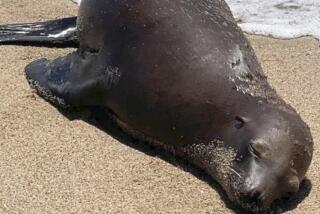ENVIRONMENT : Free-Loading Sea Lion Makes U.S. Cut Bait : Hungry creature and kin are endangering steelhead trout. Government has run out of ways to discourage them.
SEATTLE — You can offer Sandy your congratulations. He battled the federal government and the state of Washington--Sandy absorbed everything officialdom could throw at him, including the long-distance heave-ho, rubber arrows and M-80 firecrackers.
In the face of that, Sandy had lunch and laughed.
And it appears he has won. This winter, the government said uncle.
Move over, you 500-pound gorilla, and meet Sandy, the 900-pound sea lion, who knows how to get his way. And, while you’re at it, might at well meet Sandy’s friends, too, dozens of them.
“Guess who’s back from California?” said a recent Seattle Times headline.
Sandy, known by his radio collar as No. 42, is among a marauding band of young male California sea lions that you may have heard about in recent years. Each winter since the mid-1980s, an ever-growing band of sea lions has been drawn here north of its traditional territory. Here, within sight of downtown Seattle high rises, the sea lions have discovered a delicious and very weak link in the food chain.
At the Ballard Ship Locks, which connect saltwater Puget Sound on the west of Seattle with freshwater Lake Washington on the east, the California sea lions have found a winter feast of steelhead, a prized ocean-going trout. The fish gather en masse at the dam at the foot of the locks as they head for their spawning grounds in the lake, and a sea lion barely has to do more than open its mouth and inhale.
Which could be a mere urban wildlife novelty if it wasn’t for greed.
Sandy can eat 60 to 75 pounds of steelhead a day. Federal officials estimate that there are up to 40 sea lions visiting Puget Sound for the winter, with three to five of them swimming lazily in front of the locks on any given day, mouths agape.
From 60% to 70% of the winter steelhead heading into Lake Washington end up fattening the sea lions, according to the National Marine Fisheries Service. Last year, only half of the minimum number of fish needed to sustain a healthy population of Lake Washington steelhead made it past Sandy and the gang.
Fishery biologists and Indian tribes that have fishing rights to the steelhead now fear for the very survival of the fish.
The perplexing part is that both the sea lions and the steelhead are protected under laws that are now in conflict. Different government agencies with differing mandates this month conceded failure in costly--and sometimes hugely entertaining--efforts to rid the area of sea lions.
The hope for saving the winter steelhead of Lake Washington now rests with scientists who are looking at the fish themselves. Can a way be devised to hurry the steelhead up the existing fish ladder at the locks? Salmon don’t dally on their way up and are not so endangered by the sea lions. Otherwise, biologists are pondering whether they can fashion protective barriers to keep the steelhead separated or hidden from the sea lions.
“We’re trying to get funding, but we haven’t had much success,” said Eric Knudsen of the U.S. Fish and Wildlife Service.
One idea is to put lights on the fish ladder in the hope that the steelhead will be attracted to climb up the ascending pools of water faster. Another suggestion is to flush freshwater down the fish ladder instead of saltwater. Maybe the steelhead will like that better.
And biologists say they need to begin tagging the steelhead with tiny transmitters to learn their basic migration patterns.
Meanwhile, Sandy and the other blubber boys have learned all they need to know: If you persevere, if you have an endearing face and if you weigh nearly half a ton, even the government cannot stand in your way forever.
Two winters ago, batches of the sea lions were caught and trucked to the coast of southern Washington. They returned almost as fast as the trucks. Last winter, at a cost of about $15,000, six of the creatures were crated up and shipped back to their breeding grounds at California’s Channel Islands as a test. Four returned, including one who made the 1,300-mile trip in 30 days.
In between, they were forced to listen to loud music and the recorded sounds of predatory killer whales. They were bombarded with firecrackers and rubber arrows. They were fed fish laced with chemicals that induced vomiting.
To that, Sandy and the bunch seemed to have only one question: OK, when’s dinner?
More to Read
Sign up for Essential California
The most important California stories and recommendations in your inbox every morning.
You may occasionally receive promotional content from the Los Angeles Times.










